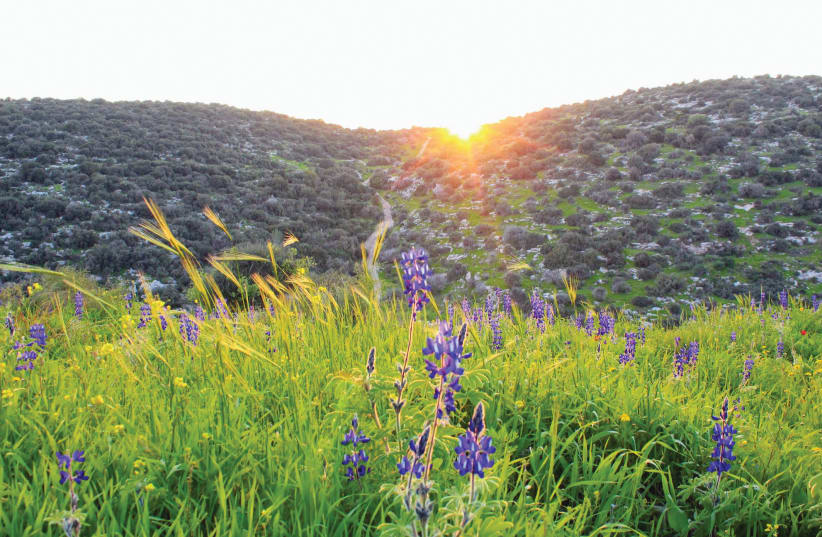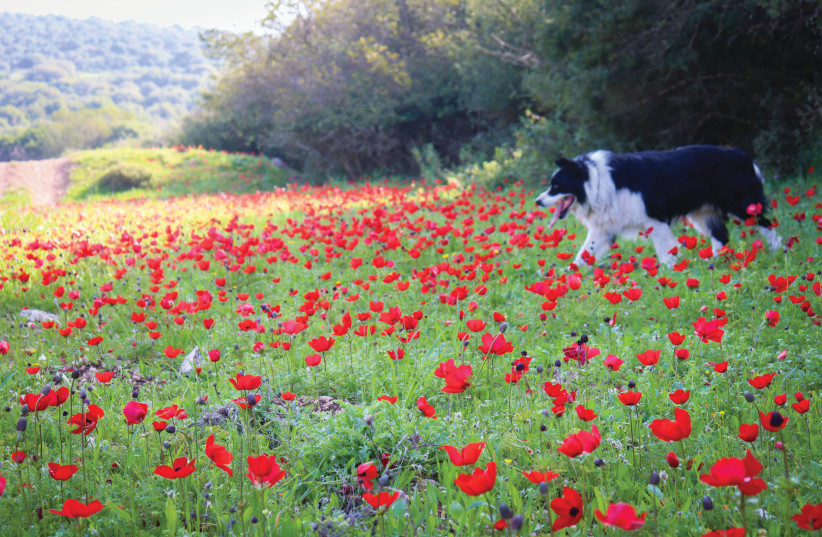I’m walking through a field of wildflowers. Red ones. Cheery anemone blossoms bob in the wind here in Adulam Reserve; they’re interspersed with purple butterfly orchids, yellow mustard flowers, and bright green blades of grass.
As I make my way through this quiet field, I feel joy rising inside of me, the kind only a field of spring wildflowers can inspire. It’s beautiful here. One can’t help but feel thankful for the winter rains that laid the groundwork for this scene here and elsewhere around the country.
Flowers, like these crimson anemones, feel simple and fleeting. In February or March, they rise from the earth as if out of nowhere and then disappear entirely, leaving no visible trace. Come summertime, these very same fields in the Jerusalem Lowlands are golden and bare.
A similar fate awaits the glorious, purple lupine-covered hill of Tel Socho nearby. Just a bit further down the road at Tel Azekah, the masses of pink cyclamen will also vanish. But despite the capricious nature of the blossoms that grow in this area, the terrain is enduring and full of history, including settlement and conquest amid season after season of wildflowers.
When I first moved to Israel, my family settled nearby in Beit Shemesh, a few minutes from Adulam, Azekah, and Socho. I remember our very first trip up to the top of Givat Haturmosim, as Tel Socho is commonly called. With my husband and two small children, I climbed to the top of what seemed like a mountain at the time. On the hilltop, we were greeted by reams of glorious purple lupine flowers, or turmosim in Hebrew, along with crowds of people who had come to see them.
We had a picnic in a quiet spot and sent our small children to wander through the tall flowers. The kids posed for lots of pictures. Then we climbed back down the hill and set out for home after a fun day, without giving Tel Socho deeper reflection.
Years later, I learned that Tel Socho was no natural hill. Rather, it was a tel, or an accumulation of ancient settlements that had turned the natural terrain into a hill-like mound. Past the purple wildflower explosion, one could see crumbling walls, old olive presses, and the remains of ancient structures concealed amongst the greenery and under trees. I noticed none of this on our first trip to Givat Haturmosim, blinded as I was by the natural beauty of the place.
Socho is first mentioned in the Bible before David’s historic encounter with Goliath – the Philistines (who inhabited the low area past the Jerusalem Hills, now central Israel) camped between Socho and nearby Azekah prior to the battle. As every elementary student knows, David killed Goliath with a stone shot from a shepherd’s sling.
Sometime after this famous battle, Socho became an official Judean city, fortified by King Rehoboam. Still later, it may have been the hometown of an important Mishanic figure, Antigonus of Socho.
If we want to go a bit deeper into the story of David and Goliath, we can find more food for thought back at Adulam Reserve. Of course, Adulam is full of natural beauty in addition to history. Anemones, the national flower of Israel, grow here during late winter. Hike any trail through Adulam during this season, and you’re sure to stumble into a field of red wildflowers. Early in the morning and towards sunset, you may see a gazelle or two prancing through these very fields.
Adulam has a far deeper meaning than its great looks
But Adulam is so much more than just a pretty place. This area is full of historical remnants, including Second Temple towns, Bar Kochba tunnels, and hidden structures. Tel Adulam, the site of the ancient biblical city of Adulam, is located right in the middle of the park.
Just like Socho, Adulam was an important spot to the early Judeans, especially during the time of David’s battle against Goliath. Located at the edge of the Jerusalem hills, Adulam was a frontier city, a convenient base for battle planning against the Philistines who inhabited the coastal region and flatlands.
Later, King David famously hid in a cave in Adulam, where he found refuge from murderous King Saul. Today, the caves of Adulam are concealed just beneath the surface, under green fields and red blossoms that sway in the wind.
Nowadays, Tel Azekah is the place where tourists go to learn about the battle of David and Goliath. From the top of this hill, one can see the entire Valley of Elah, where the battle took place. In the distance, Tel Socho and the low hills of Adulam are visible as well.
When I first visited Tel Azekah, I was initially taken in by the carpets of pink cyclamen. Beneath the trees, wildflowers blossomed abundantly. Our kids loved it there, and we made sure to enjoy a proper picnic with a red checkered blanket in a field of flowers.
After lunch, when we finally made it to the top of the hill, we were completely captivated by beauty of a different sort: there, passages from the books of the Prophets were carved into big slabs of stone, depicting our nation’s history, the lives of our ancient kings and holy men.
We read about King David, and gazed out at the valley where his battle took place long ago. There at Tel Azekah and at other sites along the ancient Judean frontier, natural beauty and our national history come together to showcase the relevance of biblical sites to our own lives.

